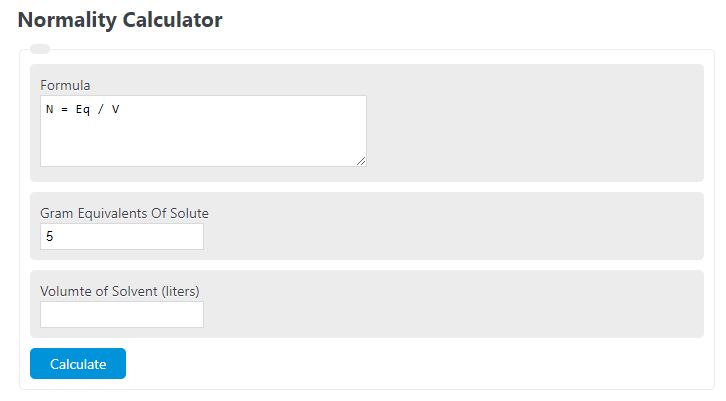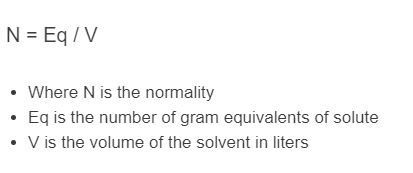Enter the number of gram equivalents of solute and the volume of solvent into the calculator to determine the normality.
Normality Formula
The following formula is used to calculate the normality of a concentration.
N = Eq / V
- Where N is the normality
- Eq is the number of gram equivalents of solute
- V is the volume of the solvent in liters
The number of gram equivalents of solute is the measure of the total amount of a substance in moles multiplied by its valence.
The volume of the solvent in liters refers to the amount of liquid that is used as a dissolving medium in a solution.
Normality (chemistry) Definition
Normality in chemistry refers to the concentration of a substance in a solution. It is defined as the number of equivalents of a solute per liter of solution. Equivalents, in this context, represent the number of moles of a solute that can undergo a specific chemical reaction.
Normality is important in chemistry because it allows scientists to measure the reactivity of a substance in a solution. By knowing the normality, chemists can determine the quantity of a substance required for a reaction, as well as predict the extent to which the reaction will occur. This information is crucial for accurate and efficient experimentation, as it helps in determining the appropriate amount of reactants needed and ensures the desired outcome of the reaction.
Normality is particularly useful in acid-base reactions. Since acids and bases can vary in their strength, normality provides a standardized measure to compare their reactivity. By knowing the normality of a specific acid or base, chemists can make precise calculations for neutralization reactions and other acid-base reactions.
Normality Example
How to calculate normality?
- First, determine the gram equivalents of the solute
Calculate the gram equivalents of solute.
- Next, determine the volume of solvent.
Measure the volume of the solvent in liters.
- Finally, calculate the normality.
Using the formula above, calculate the normality.
FAQ
How do you calculate the gram equivalents of a solute?
The gram equivalents of a solute can be calculated by multiplying the number of moles of the solute by its valency (the number of electrons that an atom can lose, gain, or share when it reacts with other atoms).
Why is normality important in chemistry?
Normality is important because it provides a measure of the reactive capacity of a solution, which is essential for accurately predicting and carrying out chemical reactions, especially in titrations and neutralization reactions.
How does normality differ from molarity?
While molarity measures the number of moles of solute per liter of solution, normality measures the number of gram equivalents per liter. Normality takes into account the valency of the solute, making it a more useful measure for reactions where the solute’s valency plays a significant role.
Can normality change with temperature?
Yes, since normality depends on the volume of the solvent, which can expand or contract with temperature changes, normality can vary with temperature. This is especially relevant in precise chemical reactions where temperature control is crucial.

